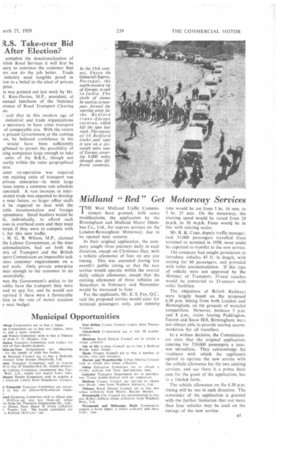Motorway Services
Page 39

If you've noticed an error in this article please click here to report it so we can fix it.
time would be cut from 5 hr. 16 min. to hr. 25 min. On the motorway, the cruising speed would be raised from 24 m.p.h. to 50 m.p.h. Fares would be in line with existing scales.
Mr. R. K. Cope, deputy traffic manager, said 51,000 passengers travelled from terminal to terminal in 1958; most could be expected to transfer to the new service.
The company had sought permission to introduce vehicles 45 ft. in length, with seating for 60 passengers, and provided with toilet accommodation. If this type of vehicle were not approved by the Minister of Transport, 37-seat coaches would be. converted to 33-seaters with toilet facilities.
The objections of British Railways were largely based on the proposed 6.30 p.m. timing from both London and Birmingham, on the grounds of wasteful competition. However, between 5 p.m. and 8 p.m., trains leaving Paddington, Euston and Snow Hill, Birmingham, were not always able to provide seating accommodation for all travellers.
In a written decision, the Commissioners state that the original application, catering for 524,000 passengers a year, was unrealistic. They acknowledge the readiness with whic.h the applicants agreed to operate the new service with the vehicle allowance for the two existing services, and say there is a prima facie case for the grant of the application, but in a limited form.
The vehicle allowance on the 6.30 p.m.' timing will be two in each direction. The remainder of the application is granted with the further limitation that not more than four vehicles may be used on the timings of the new service.




































































































